Chanpuru Review: Hide-Chan
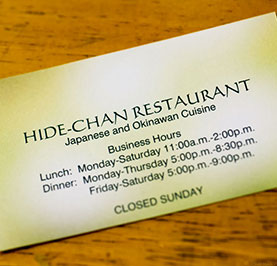
Hide-Chan Restaurant
Hide-Chan Restaurant
2471 S. King Street
Honolulu, HI 96826
Phone: 808.942.7900
Hours of Operation: Open Monday to Saturday. Closed on Sunday. Lunch (11 am to 2 pm) and Dinner (Monday-Thursday, 5 pm to 8: 30 pm and Friday-Saturday, 5 pm to 9 pm).
All photos by Todd Maeda Photography.
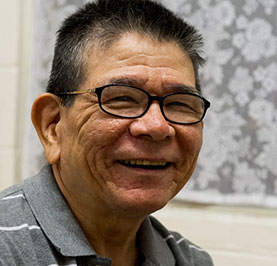
Background of Hide-Chan
Hide-Chan is an unpretentious, neighborhood gathering place. It is a family owned and run restaurant, something you don’t see too much of these days.
At the heart of it is Hidemitsu Tamayose, who does most of the cooking in the back. Hidemitsu left Naha in 1970 to come to Hawaii. While going to school to learn English, he washed dishes at the Nuuanu Onsen Teahouse. Hidemitsu worked at several different restaurants before deciding to open Hide-Chan in 2001.
The original menu had only Japanese food but Okinawan dishes were added to the menu at the request of customers. In the current menu, there are around 60 Japanese and 12 Okinawan dishes.
In the kitchen, Hidemitsu is assisted by son Joey. The front of the house is run by wife Chizuko and daughter Iris, with help from family friends.
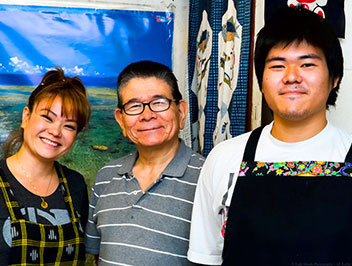
Important Info to Know
Parking is limited to several stalls out front. I usually find parking on King Street and around Moiliili Neighborhood Park. You can also park at First Hawaiian Bank (after banking hours) for a $2 charge. The place seats 24 people.
If you do go with a large party (max of 10 people), then call in advance. The restaurant does not take reservations but they can try to save you seats.
Bring cash because they do not accept credit cards. Hide-Chan is BYOB, so you can bring in bottles of awamori or Orion beer to enjoy with your meal. If drinking wine, please remember to offer some to Chizuko and Iris!
The Food
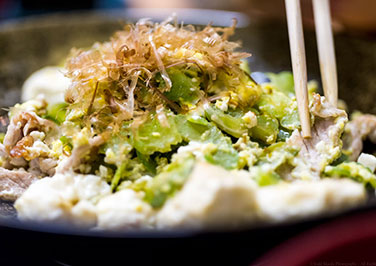
Goya Chanpuru
Champuru or Chanpuru is considered a mainstay dish of Okinawan cuisine. It is a stir fry of tofu, egg, goya (bittermelon), and pork. You can opt for Spam instead of pork. Me, I like the pork.
Hide-Chan tops theirs with katsuobushi flakes (that wave at you!) I found the chanpuru to be a nice combination of flavors, the bitterness of the goya is mitigated by the tofu and egg. I liked that the dish was not oily or heavy.
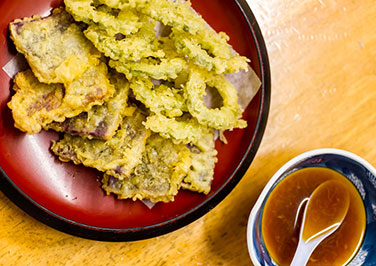
Imo and Goya Tempura
This tempura was light with a nice crunch. Not oily.
Definitely tasted the bitter goya flavor but when dipped into the sauce provided, the bitterness was cut down.
It nicely complemented the rich flavors of purple Okinawan sweet potato.
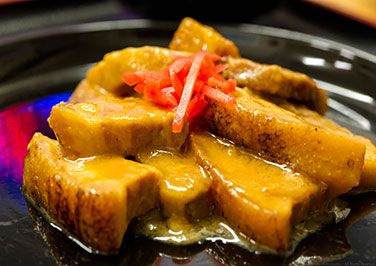
Miso Rafute
Rafute is a melt-in-your-mouth tender pork belly. I do a happy dance when I find good rafute! Hide-Chan’s rafute has a good balance between fat and pork meat. It is not greasy at all. I liked that the flavor of the miso sauce is not too bold. Love eating this on top of hot white rice. I have not seen any other place offering miso rafute in Hawaii. Hidemitsu tried this in Okinawa and created his own version of it. It is featured in Hui O Laulima’s Chimugukuru cookbook. This rafute made me do a happy dance!
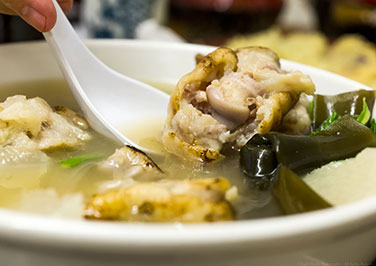
Ashitibichi or Pigs Feet Soup
Our soup came with the hock of the pig, rather than the toes, as well as konbu, daikon, and mustard cabbage. There was a nice flavor to the broth, from that wonderful richness that comes from collagen. It was lighter than I expected. There was also an accompaniment of hand grated ginger.
I will admit that I was intimidated by this dish. As I stared at the soup, I wondered, “How the heck do I eat the pig foot!”
So I asked Grant Sandaa Murata, chef and Okinawan food enthusiast, to help me understand Ashitibichi. He advised me to press the foot with my chopsticks to see if the meat falls off. If yes, then take the meat off of the side and look for the collagen (fat) in the split between the bones. All of the flavors of the ingredients should have gone into the fat, making the taste sublime. Grant also advised putting in a bit of the grated ginger to the soup before eating. Some people opt instead to dip the pigs foot into a mix of shoyu and ginger.
Grant mentioned that when he eats at Hide-Chan, he really feels like he is back in Okinawa and it evokes nostalgic food memories. For me, it is a wonderful connection to the place my grandparents came from. On this visit, I wasn’t able to try the Sokibuni nu Shimun (Sparerib soup), Nakami, Okinawan soba, and the popular Oxtail soup. I’m definitely going back to Hide-Chan with a bottle of awamori! Hope to see you there!
Need Your Help! If you have information you want to add to this review or want to suggest other places to visit, please email me at: pigsfromthesea@gmail.com
All photos by Todd Maeda Photography